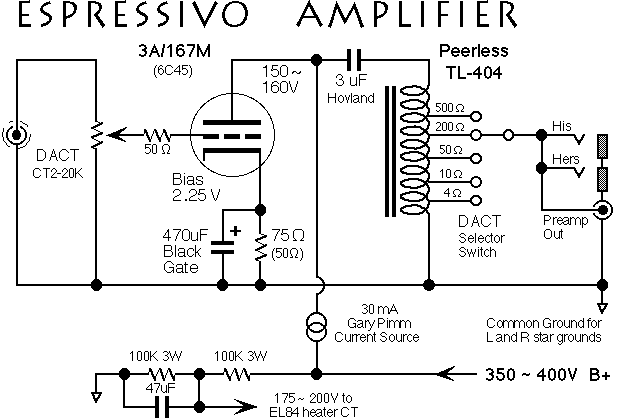Amplifier, Text, and Photos
by Gary Dahl
After much anticipation, and an all-day solder-fest, my new headphone amp was playing music for the first time about 10:30PM Saturday evening. Much to my relief, it worked right away! This is a good thing, because I didn't use my usual first-time process of bringing it up slowly with a Variac.
The circuit has several interesting features. The amplifying tubes are 3A/167M's, which are Loktal versions of the rare and expensive Western Electric 437A. As it turns out, the 3A/167M's are even more rare and expensive, but I already have a good stash. The 3A/167M features high gain (about 41) and low plate resistance (approx. 1K). These electrical characteristics are shared with the current-production Sovtek 6C45, which can be substituted for the 3A/167M or WE437A if the cathode resistor is changed to 47 or 50 ohms.

Another feature of interest are the Peerless TL-404 autoformers. These were originally designed for MGM Studios for driving headphones. An autoformer has a single tapped winding, as opposed to a transformer's separate primary and secondary. As such, the TL-404 is designed to be operated in parallel-feed, with the DC blocked by a series capacitor. The operating current for the tube traditionally would be fed through a plate-loading choke.
The TL-404 has a 5K "primary" impedance along with a wide range of output impedances. Since the 3A/167M (or 6C45) has a dynamic plate impedance of 1K, the source impedance seen by the headphones is one-fifth the rated impedance of each tap, offering a range from 100 ohms down to 1 ohm. When you rotate the impedance selector switch, the output voltage drops, but the load presented to the triode gets easier to drive. Think of it as a five-speed transmission: instead of torque vs RPM, you are controlling volts vs milliamps. This lets you "tune" the amplifier for each headphone, and makes driving two headphones in parallel as simple as selecting the next impedance tap downward. (It's also a good idea to have both pairs from the same manufacturer.)
If the Espressivo is used a preamp/line driver, you can select the effective forward gain (and output impedance) to match your power amplifier. This avoids the awkward situation of always having to run the volume control at the top or bottom of its rotation. In addition, since the Espressivo is a small zero-feedback power amplifier, it can easily drive very long lengths of cable with no stability problems. When the 50-ohm tap is selected, for example, you have a gain-of-4 linestage with a 10-ohm source impedance, a peak current capability of 300 mA, and triode sonics!
3A/167M triodes, EL84 current sources, 6CJ3 damper diodes,
and Black Gate 47/47uF 500V WKZ capacitor.
Instead of plate-loading chokes, I used a pair of Gary Pimm's superb pentode-mosfet cascode constant current sources (PMCCCS), which I had already used successfully in the Aurora amplifiers . The PMCCCS circuit has an impedance of several megohms through the entire audio band, which would be impossible to achieve with a choke. Best of all, it doesn't add any transistory colorations of its own. I have heard a direct comparison of the sound using choke loads, PMCCCS, and solid-state current sources. Pimm's circuit wins this one easily.
The B+ supply (on the right side of the photo) consists of an oversized power transformer and choke, a pair of 6CJ3 damper diodes used as a full-wave rectifier, and a Black Gate 47 + 47 uF/500 V WKZ capacitor. The whole thing runs with delightful silence. No background noise at all.
From left to right, DACT controls, TL404 autoformers, 3A/167M Loktal sockets,
Hovland caps, Gary Pimm current sources, EL84 sockets, and power supply.
I have listened to two different Beyers so far (one borrowed), Senn 580's and 600's (borrowed), along with my newly arrived Audio-Technica W1000 and W100's. It has been fun comparing the sounds on different impedance taps with each headphone.
So far everyone who has listened has been absolutely delighted. This is certainly the best sound I've ever heard on headphones!